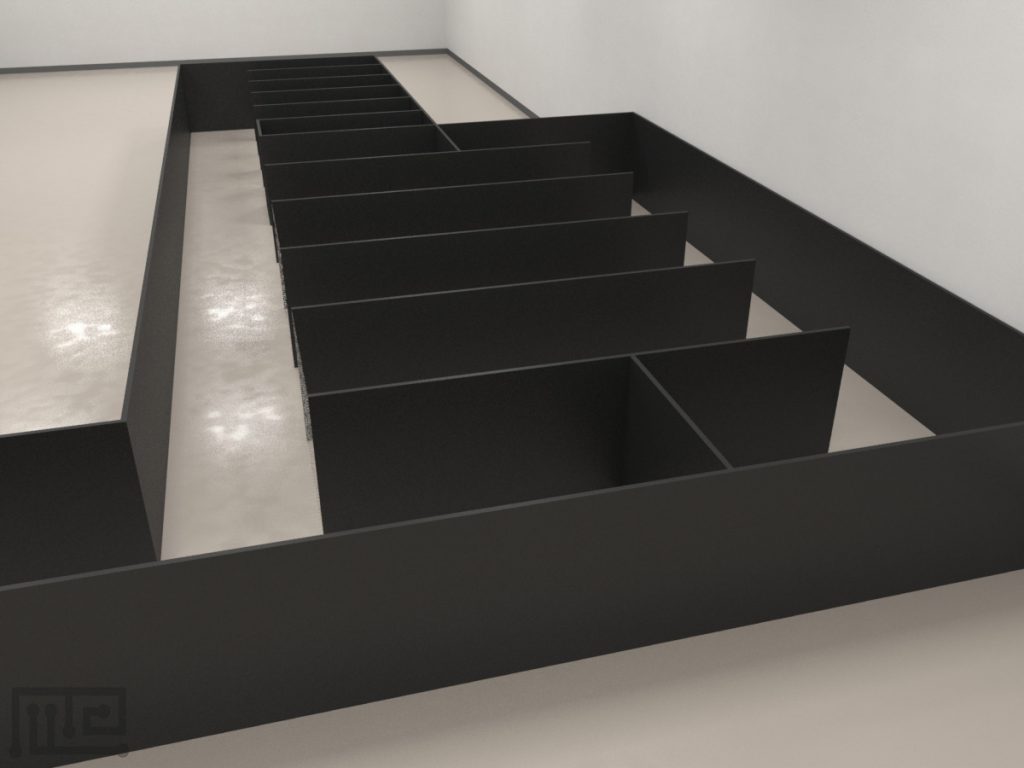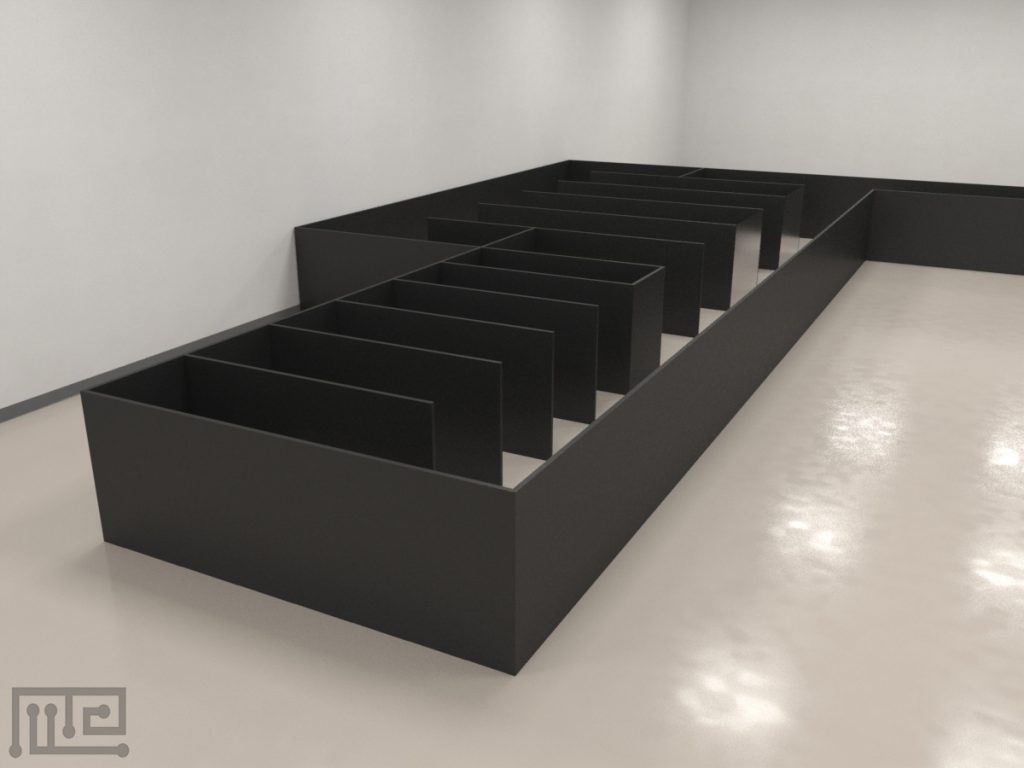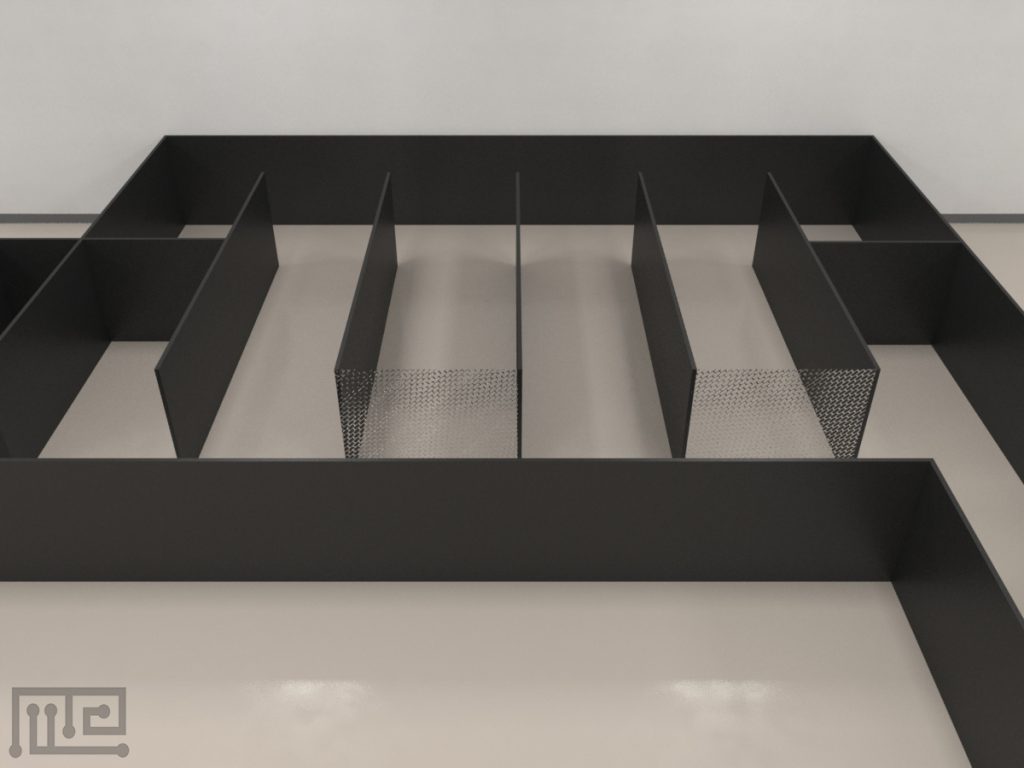The Dog Maze Arena can be used to carry out various cognitive experiments. It has long and short corridors as well as dead ends. It was used by Oliver Burman et al. (2011), in a judgement bias test to measure positive affective state in dogs.
A test of cognitive (judgement) bias was carried out, based on the finding that individuals experiencing different affective states judge ambiguous stimuli differently, to measure whether a positive low arousal affective state (e.g. ‘satisfaction’/‘contentment’) could be induced in domestic dogs as a result of their experiencing a food-based rewarding event.
Mazeengineers offer the Dog Maze Arena.
Price & Dimensions
Dog Maze Arena
$ 1990
+S&H- Length of Maze: 12m
- Length of entrance to maze: 10m
- Width of maze: 5.2m
Documentation
Introduction
The Dog Maze Arena is a spatial navigation reward-based task. It consists of an arena containing long and short corridors. The arena is equipped with solid barriers or mesh barriers to create dead ends and to introduce complexity in the task. The arena can be used to provide the subjects with a form of enrichment.
The Dog Maze Arena can be used to carry out various cognitive experiments, such as measuring the affective/emotional state of dogs. The studies on the affective state of animals have shown that the acquisition of rewards tends to induce a positive affective state in the subjects (Verbeek, Ferguson, Quinquet de Monjour, & Lee, 2014; McGowan, Rehn, Norling, & Keeling, 2013). In the Dog Maze Arena, the subjects are tasked to find food rewards that are either scattered or hidden. In contrast to other apparatuses such as the Light/Dark Box and the Elevated Plus Maze that focus on studying the negative emotional state of the subjects, the Dog Maze Arena is non-aversive and can be used to induce a positive emotional state. The Dog Maze Arena can hence be used as a pre-requisite to measure the affective state of dogs in cognitive bias tasks, which can help improve animal welfare practices.
Other apparatuses used in the evaluation of dog behaviors include the Dog Canine Radial Arm Maze, the Dog DNMS Test Apparatus, and the Canine Plus Maze.
Apparatus and equipment
The Dog Maze Arena measures 12 m in length and 5.2 m in width with a 10 m long corridor that provides entrance to the arena. The arena consists of long and short corridors. Solid barriers are equipped into some of the corridors to create dead ends. In addition, mesh barriers that allow the subject from seeing the food source but inhibit access are equipped into a couple of other corridors.
Training Protocol
Clean the arena before and after every trial to prevent the influence of any odor cues from previous trials. Appropriately light the apparatus. A tracking and recording system such as the Noldus Ethovision XT can be used to assist with observations.
The following is a sample protocol for the assessment of cognitive bias in dogs using the Dog Maze Arena:
Habituation and Pre-training
Bait the arena with food. Release the subject into the arena and allow it to explore and familiarize itself with the arena. Conduct each habituation session for 5 min a day for 5 days.
Dog Maze Arena Task
Bait the arena with food. Release the subject into the arena and allow it to find the food rewards within 5 min. Return the subject to the release point and conduct two additional trials. Conduct trials for 3 consecutive days.
Cognitive Bias Training Trials
Place a rewarded or unrewarded goal box, each consisting of a specific shade of grey, 6 m from the subject. Release the subject and allow it to reach the box within 30 s. Conduct trials until the subjects run faster to the rewarded goal box than the unrewarded goal box. Conduct six consecutive trials with half being rewarded and half unrewarded.
Cognitive Bias Task
Place one of three probe boxes (each consisting of a separate ambiguous shade of grey) between the two reference shade boxes from training trials. Bait one of the reference shade boxes. Release the subject and allow it to choose a goal box.
A positive or negative cognitive bias can be evaluated by observing if the subject responds optimistically or pessimistically to the ambiguous stimuli.
Data Analysis
The following can be observed using the Dog Maze Arena:
- Time taken for the subject to reach the maze entrance from the release point
- Number of food rewards consumed
- Time taken to consume the food rewards
- Time taken to complete a trial
Literature Review
Evaluation of cognitive bias in dogs after spending time on the Dog Maze Arena
Burman et al. (2011) evaluated whether dogs would demonstrate a positive cognitive bias when presented with ambiguous stimuli after undergoing food rewarded trials on the Dog Maze Arena. Twelve female beagles between 11 and 12 months were divided into two treatment groups (neutral and post-consumption) and used in the study. The subjects from the post-consumption treatment group first experienced a rewarding event on the Dog Maze Arena, where they were required to search for food and then perform the cognitive bias task. In contrast, subjects from the neutral treatment group did not undergo Dog Maze Arena trials and were immediately required to perform the cognitive bias task. Results from the arena trials indicated that the subjects were able to find all the food rewards at an average of 3.2 min. During cognitive bias testing, the subjects were trained to reach goal boxes that were 6 m away. The subjects were first presented with either a rewarded or unrewarded goal box that was of two different shades of grey. It was observed that the subjects took significantly longer to reach the unrewarded box. No significant effect of treatment was observed in latency to reach the box. The subjects were then presented with the two reference shade boxes along with either one of three probe boxes (near rewarded, middle, and near unrewarded). Results indicated no significant difference between the two treatments for the near rewarded and near unrewarded probes. However, the subjects took significantly longer to approach the middle probe from the post-consumption treatment group. Overall results indicated that the subjects displayed a negative cognitive bias after the post-consumption treatment.
Strengths and Limitations
Strengths
The Dog Maze Arena is a spatial navigation reward-based task. It can be used as a form of enrichment that can induce a positive affective state in the subjects. The corridors of the arena can be equipped with solid barriers as well as mesh barriers to create dead ends and to increase the complexity of the task. It is a non-aversive task and, therefore, does not elicit any form of stress in the subjects. The subjects can easily be trained using the apparatus, and the task can be performed in a short amount of time. The Dog Maze Arena can be used as a pre-requisite to various experimental protocols, such as measuring the cognitive bias of the subjects after experiencing a rewarding event.
Limitations
The exploratory behavior of the subjects is highly important in the performance of the task. Unintentional stimuli may interfere with the way the subject performs the task. Factors such as age, gender, and strain of the subjects may affect task performance.
Summary
- The Dog Maze Arena is a rectangular arena that contains long and short corridors as well as solid and mesh barriers that create dead ends.
- The Dog Maze Arena can be used in various cognitive studies, such as those measuring the affective state of the subjects.
- The Dog Maze Arena can be used as a form of enrichment as well as to improve animal welfare practices.
- The Dog Maze Arena is non-aversive to the subjects.
References
- Burman, O., McGowan, R., Mendl, M., Norling, Y., Paul, E., Rehn, T., & Keeling, L. (2011). Using judgement bias to measure positive affective state in dogs. Applied Animal Behaviour Science, 132(3-4), 160–168. doi:10.1016/j.applanim.2011.04.001
- McGowan, R. T. S., Rehn, T., Norling, Y., & Keeling, L. J. (2013). Positive affect and learning: exploring the “Eureka Effect” in dogs. Animal Cognition, 17(3), 577–587. doi:10.1007/s10071-013-0688-x
- Verbeek, E., Ferguson, D., Quinquet de Monjour, P., & Lee, C. (2014). Generating positive affective states in sheep: The influence of food rewards and opioid administration. Applied Animal Behaviour Science, 154, 39–47. doi:10.1016/j.applanim.2014.02.011
Request a quote
"*" indicates required fields




